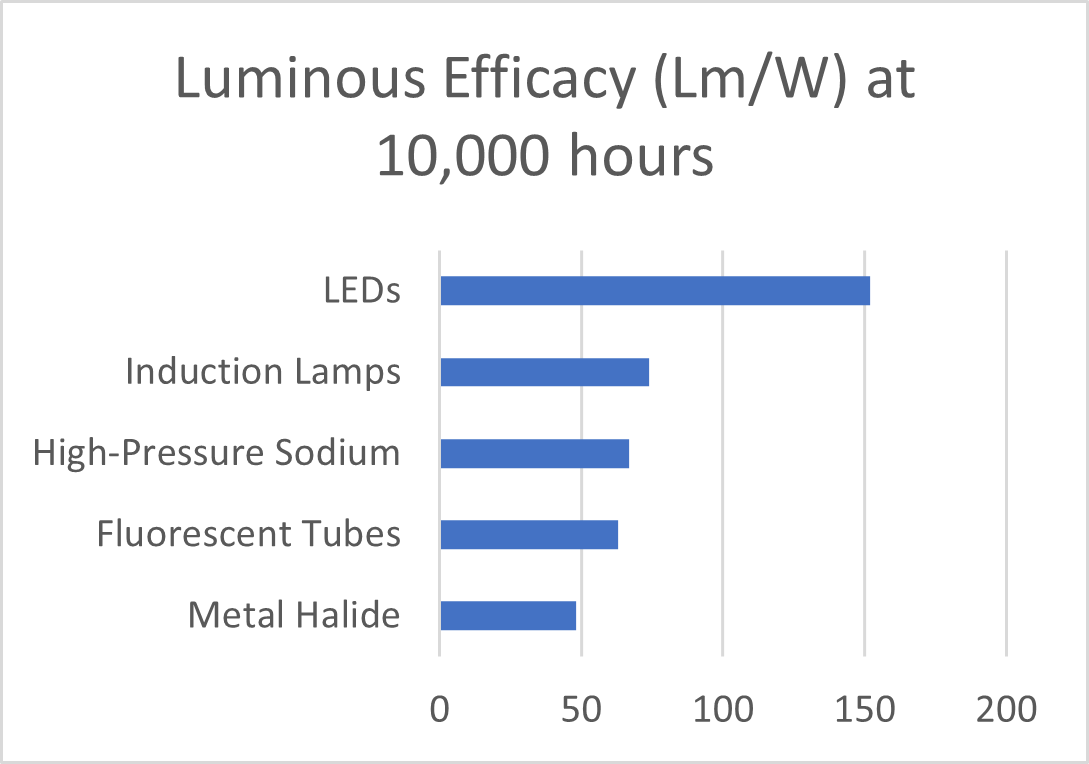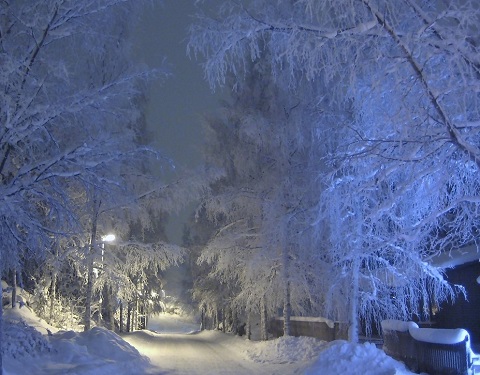How Long Can Induction Lighting Last With Continuous Operation
With so many options in commercial lighting applications, it can be hard to know which lighting technology is best for your application. Many technologies such as fluorescent tubes, metal halide, and high-pressure sodium are being replaced with LED. But what about induction lamps? How do they rank compared to other options?
The pros of induction lamps are that they are very efficient, no warm-up required, more eco-friendly, great light quality, and extremely durable. The cons are that they are bulky, not well-suited for low-watt applications, can cause RF interference, and reduce efficiency in extreme temperatures.
Here's a detailed look at these advantages and disadvantages:
Induction Lighting Advantages
Induction lighting is very efficient at producing light
The efficiency of a lamp in producing lumens is called luminous efficacy. This is calculated as lm/W, or the number of lumens per watt. However, the lumens a lamp produces will drop over time. Hence, we are going to look at the luminous efficacy after 10,000 hours of operation. That's just over 2 years of operating 12 hours a day.
At 10,000 hours of operation, here is the average luminous efficacy per each lighting technology:
- Metal halide lamps: 48 lm/W (at their end-of-life)
- Fluorescent tubes: 63 lm/W
- High-pressure sodium lamps:67 lm/W
- Induction lamps: 74 lm/W
- LED's: 152 lm/W

This makes induction lighting more efficient in light-output than all HID lights. Except for LED lighting, they have higher luminous efficacy than any other lighting technology.
Induction lamps don't require warmup or restrike time
One annoying nuance of HID lamps are the warmup time and restrike time that they require. Warmup time is how long it takes the bulbs to get to full brightness. This can be between two and six minutes.
Once the bulb is turned off, it needs to cool before it can be turned on again. The cool-down time is call restrike time. Typical restrike time is between five and fifteen minutes. Hence, HID lights are not well-suited for applications that require regular on/off cycling. They are best for leaving on all night, or the entire work hours of a factory or warehouse.
With induction lighting, this is not an issue. They are at full brightness instantly and can be turned on and off at will. In addition to the inconvenience of waiting for warmup or restrike, it also adds another element of energy savings. Lights can be turned on only when needed, not in advance due to warmup time.
Induction bulbs are more environmentally friendly than typical fluorescents

Unlike most fluorescent bulbs, induction bulbs come in a sealed tube. Therefore, there isn't as great a risk of the bulb releasing mercury into the air.
Additionally, standard fluorescent tubes only last 20,000 hours. Induction fluorescent lighting, on the other hand, lasts 100,000 hours. That's a factor of 5x reduction in mercury production and disposal.
The added efficiency of induction lighting over fluorescent tubes adds another 15% reduction in bulbs required and mercury production/disposal. Plus another 15% improvement due to less energy production and consumption. Take all these factors into account, and induction bulbs are 7x better for the environment than regular fluorescent bulbs.
Induction lamps have excellent light quality
What makes a great light isn't just how many lumens it can emit. It has to do with how well it performs its desired function. For general visibility, the VEL, or "visual effect lumens" is what counts. This means how well the light source helps us to see clearly.
Our eyes have rods (scotopic vision) and cones (photopic vision). These rods and cones balance each other out. A good light source has a high scotopic/photopic (S/P) ratio. The sun and sky combo, as a benchmark, has an S/P ratio of 2.47. The closer a light source comes to this number the more "visibility" it provides us.
On the bad of the scale, a typical yellow high-pressure sodium light has a pathetic S/P ratio of about .5. That means if an HPS lamp is producing 8000 lumens, it's "visibility" lumens is only half that, or 4000 VEL.
Here are a few S/P ratios for lighting technologies:
- High pressure sodium: .5
- Warm white 3000K fluorescent light: 1
- White high-pressure sodium: 1.14
- 2850K incandescent: 1.41
- Metal halide lamp: 1.49
- 5000K induction lamp: 1.96
- Sun and Sky: 2.47
Induction lamps have the strongest S/P ratio compared to other lighting sources. Hence, they provide better visibility than other forms of lighting technologies, due to their high visual effect lumens.
Another element of visibility is called CRI, or color rendering index. This refers to how well light sources "render" colors. Better stated, how well we can perceive true coloration of objects lighted with that light source. CRI is a scale that tops out at 100. Sunlight is the benchmark at 100. Here are the CRI ratings of various light sources:
- Metal halide: 65
- HPS: 24
- Incandescent: 100
- Fluorescent tubes: 50 – 90
- LED: 80 – 98
- Induction: 85 - 90
HID bulbs such as metal halide and HPS are inherently poor at color rendition. Incandescent bulbs are the best, rated at 100 CRI. They just are not the best choice for most applications due to their extremely poor efficacy and short life span.
Induction lamps and fluorescent tubes are dependent on the quality of the phosphors that coat the tubes to provide high CRI. As fluorescent tubes are usually more of a commodity product, the phosphors are not as high-grade. The CRI tends to be on the lower end of the scale. Induction lamps are not a commodity product, so they will almost always have a higher CRI than in fluorescent tubes.
LED's generally provide good CRI, in the range of induction lighting. ILF induction lamps have a very high-quality phosphor coating that provides CRI on the high end of the scale. Likewise, our LED lighting provides high CRI.
Another reason that induction light quality is better than fluorescent tubes is that they don't flicker. With the magnetic flux being constant, light production in the bulbs has a consistent flow.
Induction lights last longer than any other lighting technology
Remember the "good-ol' days" when we swapped out our incandescent bulbs two or three times a year? HID was a break-through we all appreciated. With metal halide, fluorescent tubes, and HPS all lasting 10 to 24 times as long, they were a great improvement. But nothing compared to induction lights. Not even LED. Take a look…
- Incandescent: 1000 hours
- Metal Halide: 10,000 hours
- Fluorescent tubes: 20,000 hours
- HPS: 24,000 hours
- LED: 50,000 hours
- Induction: 100,000 hours

While LED has some advantages over induction lighting, that's not the case when it comes to longevity.
Induction lighting simply can't be beaten when it comes to lifespan. This makes them the perfect solution for reducing maintenance costs. This is especially true when the light fixtures are a challenge to access. For instance, in locations where lifts can't access very easily, or at remote geographic locations. If you're looking for lamps that you can install and forget about for ages, definitely turn to induction lighting fixtures.
Induction Lamp Disadvantages
While there are several strong advantages of induction lights, it's best to look at the disadvantages before making the decision and pulling the trigger. So here are the cons…
Induction lamps are bulkier than other lamps
Due to the electromagnetic inductor needing to wrap around the bulb, this adds bulkiness to the design. While there are some compact induction bulbs built to be an easy retrofit for CFL bulbs, these are primarily for low-watt applications, like 50 watts or less.
In most cases, higher-watt lamps are fairly bulky regardless if they are induction lights or a different technology. Metal halide, HPS, and fluorescent tube light fixtures are usually placed outdoors, in high-bay, or drop ceilings where space isn't an issue. But in those rare occasions where tight space dictates a compact light fixture or bulb replacement, there are smaller solutions out there.
LED lights are the most compact lighting technology available. They can be configured for just about any space requirement. In addition to induction lamps, ILF also offers LED lighting options. If you need help sourcing a light fixture or bulb replacement for a tight space, give us a call. I'm sure we can help solve your dilemma.
Induction lighting can cause radio wave interference
Nowadays, everything runs on radio waves. From Cellular to Wi-Fi, Bluetooth, Zigbee, Z-wave, RFID, and a host of other wireless technologies, radio interference is something that needs to be thought through.
In most cases, the RFI of induction lights doesn't disturb other radio signals used in the facilities. High bay applications typically have the lights raised far away from devices requiring radio communications. Roadway and walkway lights are rarely an issue.
But that's not to say RFI is never an issue with induction lights. The closer the proximity of the light to the unit that requires RX/TX (transmission and reception of radio signals), the more likely an interference problem could occur.
If you have a concern about radio interference in your facility, we recommend calling our lighting experts to talk over your situation before landing on induction lighting as an HID or fluorescent retrofit.
Induction lights reduce their efficiency in extreme cold and hot temperatures
Every light has an operating temperature range. Our induction lights are rated for ambient temperatures from -40°F to 122°F. This works for most applications. But not all…
 Climate-controlled environments are pretty much always in that range. Humans, animals, and plants all prefer to be in their "comfort zone." That makes induction lights well suited for interior lighting. It's also well suited for outdoor applications, as there are not that many environments below -40°F or above 122°F.
Climate-controlled environments are pretty much always in that range. Humans, animals, and plants all prefer to be in their "comfort zone." That makes induction lights well suited for interior lighting. It's also well suited for outdoor applications, as there are not that many environments below -40°F or above 122°F.
There are places of extreme cold like Fairbanks Alaska and the far north of Russia where temperatures can drop below the operation range of induction lighting. In these frigid environments, LED lights are perfect.
The only issue you might encounter with LED lights in the cold could be low-quality components used to build the LED drivers, and perhaps expansion/contraction of soldered connections. ILF bulbs are of the highest quality. Built to handle extreme weather and cold, this is the best option.
Are induction lights right for you?
As we have seen, there are many advantages and some disadvantages of using induction lighting. While induction lights are a great choice for most applications, some may be better suited for LED or even lower-efficiency options in specialty cases.
Ready to order your light fixtures or replacement bulbs? We are here to help. Feel free to shop our catalog or give our lighting experts a call at (855) 453-2852.
Jan 27th 2021
Source: https://inductionlightingfixtures.com/blog/what-are-the-advantages-and-disadvantages-of-induction-lamps/
0 Response to "How Long Can Induction Lighting Last With Continuous Operation"
Post a Comment